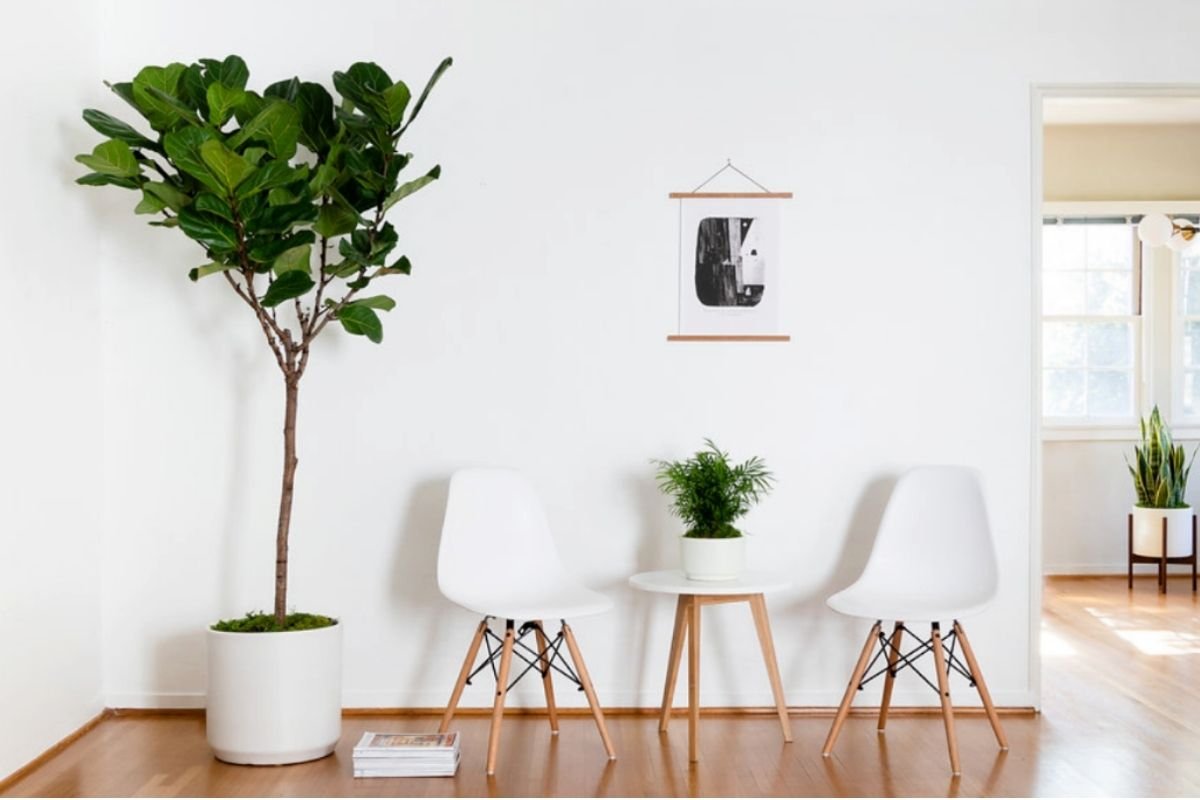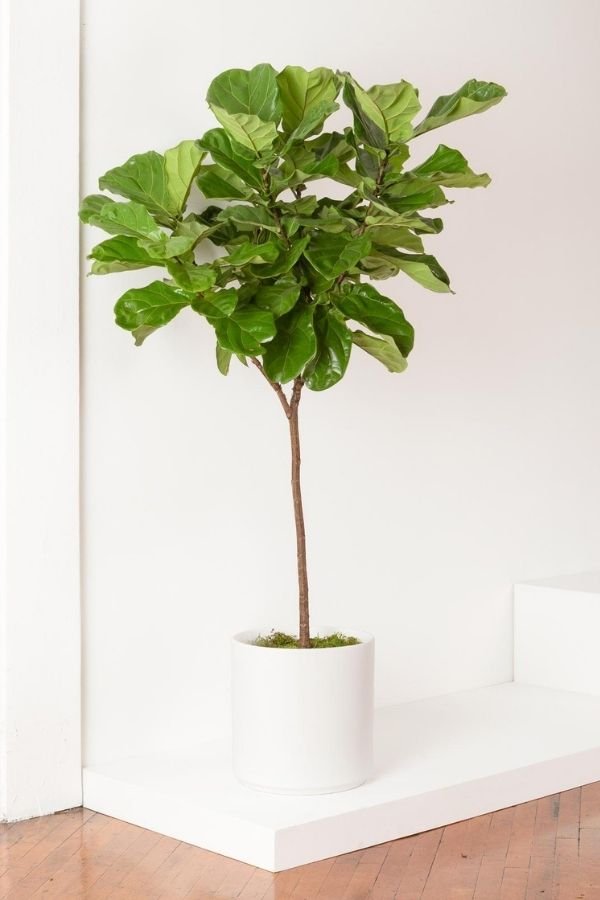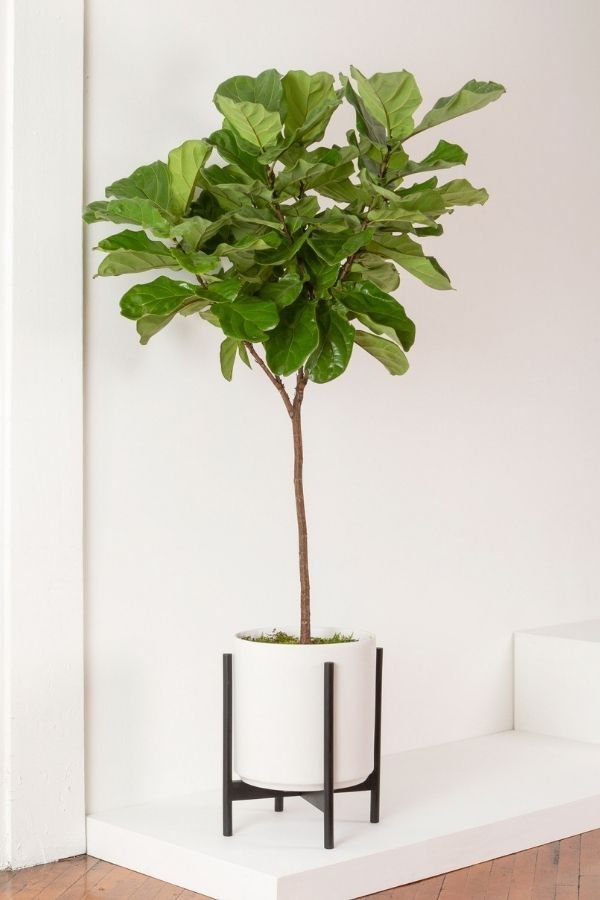What You Need To Know Before You Buy A Fiddle Leaf Fig Tree
These days, it seems like everybody wants a Fiddle Leaf Fig Tree, but only the fortunate have these beautiful statement Ficuses in their homes. And if you’re reading this, you’ve probably already decided that you’re ready to be one of the favored few!
The Fiddle, also known as Ficus Lyrata, is an interior design favorite for good reason. Tall and elegant, with a canopy of enormous violin-shaped leaves, the Fiddle is instantly sculptural and famed for its glamour. These trees are also an investment, so it stands to reason that you want to be well-educated on Fiddles before buying yours and bringing it home. Read on, because we’re sharing everything you need to know before you buy a Fiddle Leaf Fig Tree! And with so many tried-and-true Fiddle connoisseurs on our team, you can be sure that we’re speaking from experience.
Your Fiddle Leaf Fig Tree will require bright, indirect sunlight
Fiddle Leaf Fig Trees are native to Africa, where they can grow up to 100 feet tall in the wild- and where they receive plenty of consistent, bright sunlight. This level of light: bright and abundant, but not scorchingly direct, is what you’ll be attempting to imitate in your Fiddle Leaf Fig Tree’s chosen spot in your home.
Fiddle Leaf Fig Trees can tolerate some direct sunlight, but especially strong light and high temperatures will scorch their leaves, so a balance must be found between sufficient light (they really do require a lot) and light that is diffuse. Your Fiddle Leaf Fig Tree’s canopy should not be close enough to physically touch its light source (i.e. a window or sliding glass door.) Need help determining the light that your space receives? We have a light guide for that!
Fiddle Leaf Fig Trees are particular about their watering routine
Overwatering is the number one cause of poor health in Fiddle Leaf Fig Trees, and it’s easy to see why. Because Fiddles are a large statement plant and a significant investment, it is common for plant parents to want to nurture their Fiddle as much as possible. After all, plants need water to survive, right? And of course, they do- but not much. Fiddle Leaf Fig Trees should be watered only when their top 2-3 inches of soil are dry to the touch, and then no more than 2-3 cups of water at a time. Overwatering your Fiddle Leaf Fig Tree will result in browning, discolored foliage and leaf drop. An overwatered Fiddle Leaf Fig Tree is a sad thing to behold- but it can be avoided with some forethought and restraint. Moisture meters are a great way of keeping tabs on the moisture levels of your Fiddle’s soil, and when used in conjunction with manual gauging your Fiddle’s soil with your finger, you’ve got a recipe for success!
Where to place your Fiddle Leaf Fig Tree
Fiddle Leaf Fig Trees need bright, indirect light- and lots of it. However, being placed in the path of strong, direct sunlight can cause their leaves to scorch. So the ideal place for a Fiddle Leaf Fig Tree is a spot within a few feet of a window, but not directly in the path of intense rays. To get a sense of the light that your space receives, observe the way light travels through your room throughout the day and don’t forget about that handy light guide!
But overwatered Fiddle Leaf Fig Trees can be rehabilitated
An overwatered Fiddle Leaf Fig Tree will require special care and intervention. But don’t panic: Fiddles, like all living plants, will adjust and rebound with time. Overwatered Fiddle Leaf Fig Trees often require removal from their ceramic pot and a period during which their soil can dry fully. Some soil may need to be replaced, and in the case of root rot, roots may require trimming. But none of it is as dire as it sounds- and it’s all significantly less stressful with a Plant Doctor at your back. (More on that later!)
A note on toxicity in Fiddle Leaf Fig Trees
Fiddle Leaf Fig Trees are considered to be toxic and can cause illness when ingested, so be mindful of this when deciding whether to bring one home. Some find that because their leaves begin high up on their trunks, they are kept safely out of reach of curious pets. But only you can ultimately decide if a Fiddle will be a safe choice for your pet, and if you are confident that you require a non-toxic plant, don’t worry, you still have options!
Fiddle Leaf Fig Trees appreciate fertilizer during their growing months
Fiddle Leaf Fig Trees process their soil’s nutrients quickly as they grow. Those tremendous leaves and mile-high trunks require a lot of nourishment, and because of this, Fiddle Leaf Fig Trees benefit from being fertilized every two to four weeks during the spring and summer, and once every three months or so during fall and winter. The most important thing to keep in mind when fertilizing your Fiddle? It’s simple: follow the instructions! Utilize a fertilizer with a 3-1-2 N-P-K ratio (that’s 3% nitrogen, 1% phosphorus, and 2% potassium) to make sure that your Fiddle gets the nutrients it needs.
Fiddle Leaf Fig Trees can react a bit dramatically to stress
Fiddle Leaf Fig Trees have a reputation for exhibiting diva behavior, and while we wish we could say that this is never the case, we’d be doing you a disservice. It is true that Fiddle Leaf Fig Trees generally experience a longer period of adjustment than other plants. Events like transit, repotting, changes in their lighting environments and watering routines can all have an impact on Fiddle Leaf Fig Trees and cause them to exhibit stress, which does take time to resolve. One of the most important skills that a Fiddle owner should have is patience. Fiddles can require a lot of it, because it takes time for them to adjust to even small changes.
Fiddle Leaf Fig Trees require some maintenance and manicuring
Because Fiddle Leaf Fig Trees are sensitive plants that can seem to have an outsized reaction to small changes in their care or environment, they can require some special maintenance. The most common signs of stress and adjustment for Fiddle Leaf Fig Trees are foliage browning and leaf drop. Both can be unsightly, but no Fiddle is perfect. (And if you want a tree with foliage that will consistently appear pristine, a Fiddle may not be the plant for you.) It’s important to understand that maintenance is a part of Fiddle ownership. Pruning leaves off, manicuring brown or discolored edges, and occasionally rotating your tree are all standard maintenance practices for Fiddles. You’ll want to get accustomed to touching your plant.
How to select a thriving, gorgeous Fiddle Leaf Fig Tree
Once you’re ready to buy a new Fiddle Leaf Fig Tree, it’s important to know what to look for. With Fiddles, this means inspecting both the tree’s canopy and its soil. Make sure that you buy a Fiddle Leaf Fig Tree that has a full canopy of vibrantly colored leaves with minimal discoloration. It is common for Fiddles to drop a few leaves as they settle in to new environments, so starting out with a canopy that has bountiful foliage is ideal. Because Fiddles are sensitive to overwatering, you can save yourself a world of stress by carefully inspecting the Fiddle Leaf Fig Tree’s soil before purchasing. Essentially, you are looking for a tree that has moist, but not soaked soil. Additionally, check the plant and soil thoroughly for any pests. It’s relatively rare for Fiddles to experience insect issues, but an ounce of prevention is, as always, worth a pound of cure here.
Avoid purchasing your Fiddle Leaf Fig Tree from a garden center
Premium plants = premium prices. Yes, it really is that simple. But you might be wondering, do I really need a premium Fiddle Leaf Fig Tree, or can I just give a bargain tree exceptional care?
The truth is, with all living plants (and especially with statement trees like the Fiddle Leaf Fig) purchasing your tree from a premium grower makes all the difference in the world for both its appearance and its health over time.
Fiddles can be divas, and when you’re ready to buy your new tree, it’s time for you to be a diva, too: only buy a new Fiddle Leaf Fig Tree from a trusted, premium grower. Fiddles are not the plant to scoop up from a garden center or home improvement store, and we’ll tell you why.
Garden centers and home improvement stores often employ a one-size-fits-all approach to caring for the plants they have for sale. If this sounds like a bad idea, it’s because it is. Given their sensitivity to overwatering, purchasing a Fiddle from a garden center that may be providing all of its plants with the same amount of water, at the same frequency, is not recommended. Additionally, insects have a habit of hopping from plant to plant- so if you cannot guarantee that the business you’re buying your Fiddle from treats pests both prophylactically and as needed, there is a chance of bringing a pest-ridden plant into your home, where the issue can continue to spread to your other plants.
Finally, there’s the issue of transit- and it’s a big one. Fiddles are sensitive to movement of most kinds, and purchasing a Fiddle from a garden center or home improvement store, then driving it home, is not a recipe for success. Fiddle Leaf Fig Trees are large and require careful handling. They’re also sensitive to temperature changes and forced air from A.Cs and vents. It’s crucial to go the extra mile in terms of ensuring safe transit for your new Fiddle Leaf Fig Tree. That’s why we recommend purchasing your new tree from a company that either locally delivers plants by hand or utilizes plant-specific packaging.
Even the healthiest Fiddle Leaf Fig Tree can experience stress from time to time
You know by now that having a Fiddle Leaf Fig Tree in your home means that you have a new member of your family, and that you’re fully committed to taking great care of your tree. So if issues do occur and you notice your Fiddle exhibiting some diva behavior, there’s nothing more valuable than having a knowledgeable and responsive team of horticulturalists at your back.
Every plant that you buy from Léon & George comes with lifelong access to our Plant Doctor service: our team of horticultural experts that are here to offer assessments, suggest tips and adjustments and generally support you through the exciting journey of plant parenthood. There’s no catch: no fees are required. Free, lifelong access to the Plant Doctor service is just one of the ways that we work together to green up the world and ensure that every Léon & George plant is designed to thrive.
We’ve compiled a list of common problems that Fiddle Leaf Fig Trees can face, as well as helpful guidance for assessing your tree’s health. Informed and supported plant parents are the key to our success! Click here to learn more about how to care for and grow your Fiddle Leaf Fig Tree.
Shop The Classic, Sculptural Fiddle Leaf Fig Tree From
Léon & George
Look no further: your dream Fiddle Leaf Fig Tree is here. With a slender trunk and bountiful canopy of large, violin-shaped leaves in shades of verdant emerald, the Fiddle Leaf Fig Tree is a statement tree for the ages and an interior design favorite. Best for owners with some plant care experience, the Fiddle Leaf Fig Tree thrives in bright, indirect light.





